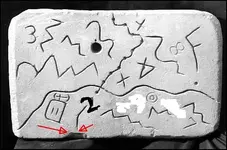Oroblanco said:
See the thing being held close to the eye? It is called a Jewelers' loupe; it is a magnifier. These start dimples would very probably be very small, less than a quarter inch certainly, unless the drill were held in place for a long time. I doubt you are going to see diddly-squat from any kind of photographs unless they are done at something like 10X and very close, as in inches away.
Oroblanco
I'm not so sure about all that. The resolution on hi-res images can pick up the grains on the sandstone, which are much smaller than 1/4 inch.
And if a magnifier blows up the grain, it's probably just going to look like a pile of boulders. So, unless there is a dimple which is distinct enough to be seen by a blowup of a hi-res digital image, would anything less be
identifiable as a "drill dimple"? I gotta say I'm about 50-50 on that one.
Another problem I have with the drill or Dremel theory, is that lots of the line ends are
tapered. To accomplish that, a person would need to go to a smaller diameter Dremel tip, and somehow make that a
gradual line width and depth change. You can make a line or mark
wider than the tip you are using, but
not narrower! And to make a line or mark which is
wider than the tip you are using, defeats the whole theory, because it puts you right back into the
variances caused by using any other "by hand" method.
Plus, there are also a lot of "over cuts," where the carved line goes past the adjoining or intersecting line. And those over cuts are all of the tapered ending type. It would be way easier to have made the Stones, by just using a non-powered rock carving tool, than it would be by using a Dremel!
I realize that I might be overlooking something regarding what I commented on in this post, and if I am, I would appreciate anyone letting me know what it is.
My opinion is that using a loupe isn't going to give any advantage over blown up hi-res photos, any more than looking at two piles of boulders and trying to see which pile might have a certain type of "dimple" in it. In other words, I think the surface is too course to get down to that fine of detail. And it would need to be mighty fine detail, if you couldn't see it up close with the naked eye, or by blowing up a hi-res digital image.
And the idea of having evidence of power tool sanding gets kind of screwy, too. I think anything
smaller than could be seen
without a loupe or magnifying glass, would be as small as the grain of the sandstone itself, and thus unobservable. I don't remember if they said "power sander" or just "hand sanded," but either way, I don't think it would be distinguishable with the graininess of the Stones. It may be possible, but I'm very skeptical of that, at this point.






